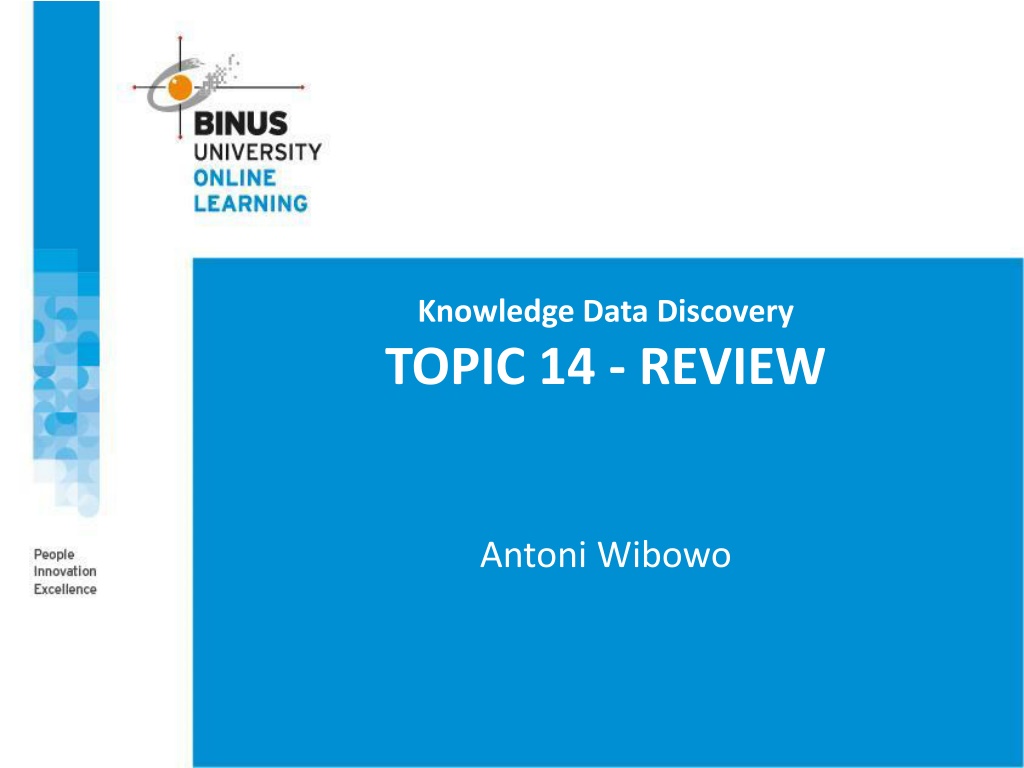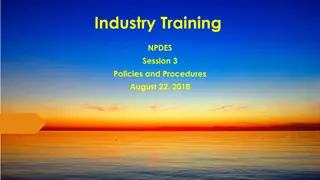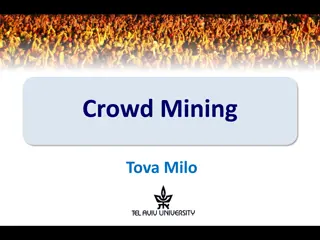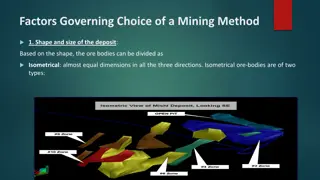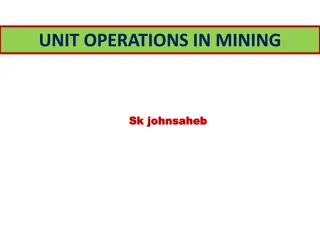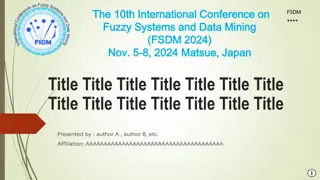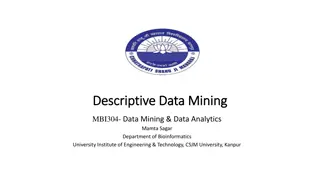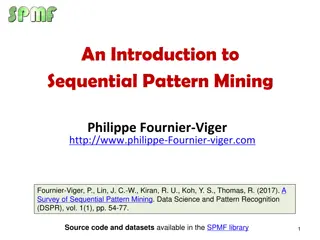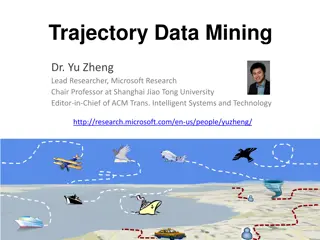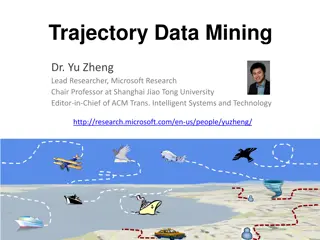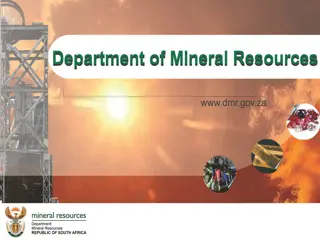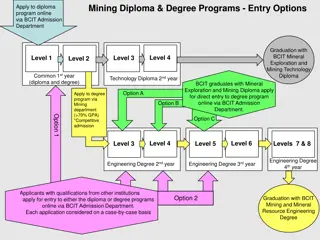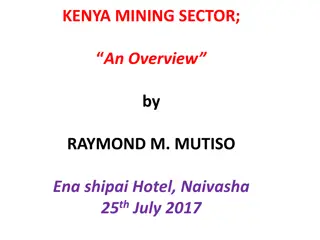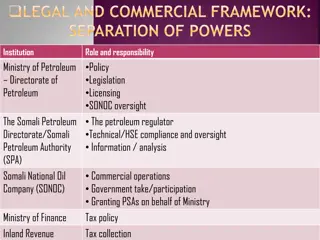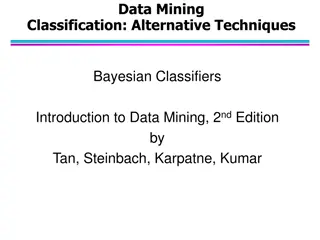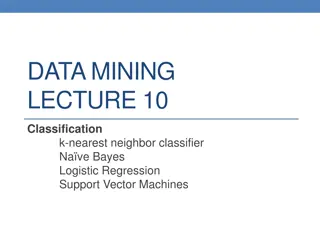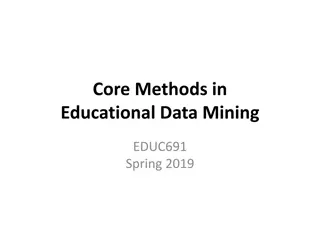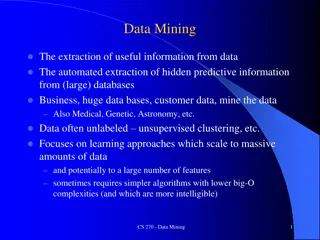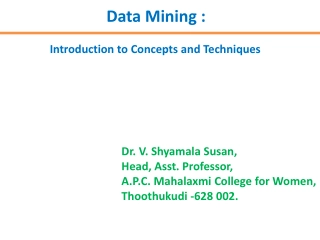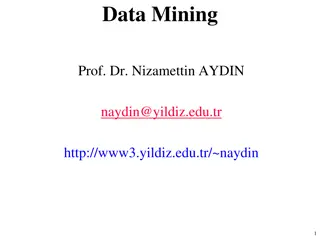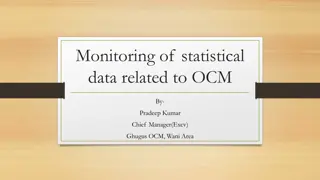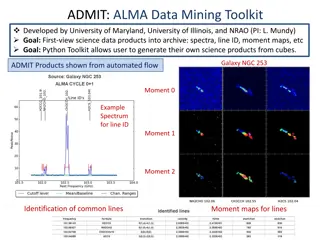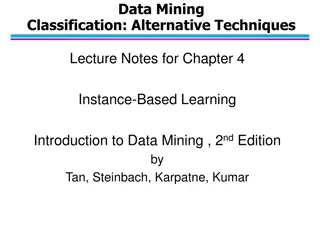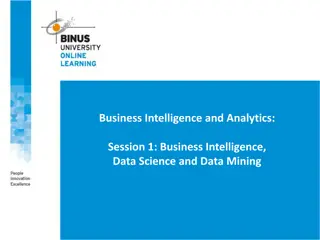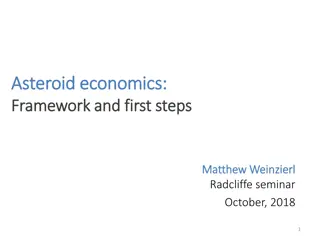Understanding Classification in Data Mining
Classification in data mining involves assigning objects to predefined classes based on a training dataset with known class memberships. It is a supervised learning task where a model is learned to map attribute sets to class labels for accurate classification of unseen data. The process involves training and testing sets to build and validate the model, distinguishing it from regression which deals with continuous values. Real-world examples of classification tasks include credit approval, fraud detection, spam email filtering, medical diagnosis, protein structure classification, and web page categorization.
Download Presentation

Please find below an Image/Link to download the presentation.
The content on the website is provided AS IS for your information and personal use only. It may not be sold, licensed, or shared on other websites without obtaining consent from the author. Download presentation by click this link. If you encounter any issues during the download, it is possible that the publisher has removed the file from their server.
E N D
Presentation Transcript
Knowledge Data Discovery TOPIC 14 - REVIEW Antoni Wibowo
COURSE OUTLINE 1. CLASSIFICATION 2. CLUSTERING 3. ANOMALY DETECTION
Note: This slides are based on the additional material provided with the textbook that we use: J. Han, M. Kamber and J. Pei, Data Mining: Concepts and Techniques and P. Tan, M. Steinbach, and V. Kumar "Introduction to Data Mining .
What is Classification? Classification is the task of assigning objects to one of several predefined classes (or categories) on the basis of a training data set containing observations (or instances) whose class membership is known. In the terminology of machine learning, classification is consider an instance of supervised learning problem The training data set is labeled data Each record (known as an instance or example) is characterized by a tuple (x, y), where xis the attribute set and y is a special attribute, designated as the class label (also known as category or target attribute)
What is Classification? Classification is the task of learning a classification model that maps each attribute set x to one of the class labels y. Goal: previously unseen records should be assigned a class as accurately as possible. A test data set is used to determine the accuracy of the model. Usually, the given data set is divided into training sets and test sets, with training set used to build the model and test set used to validate it. Note: If the test set is used to select models, it is called validation (test) set
Classification vs Regression Classification: Predicts categorical class labels Classifies data (constructs a model) based on the training set and the values (class labels) in a classifying attribute and uses it in classifying new data Regression: models continuous-valued functions, i.e., predicts unknown or missing values
Examples of Classification Task Banking: Credit/loan approval Fraud detection: if a transaction is fraudulent Detecting spam email messages based upon the message header and content Medical diagnosis: Predicting tumor cells as benign or malignant based upon the results of MRI scans Biology: Classifying secondary structures of protein as alpha-helix, beta-sheet, or random coil Web page categorization: Categorizing news stories as finance, weather, entertainment, sports, etc
Classification Two-Step Process 1. Model Construction: describing a set of predetermined classes Given a set of labeled data set (as training set) for model construction The model is represented as classification rules, decision trees, or mathematical functions (classifiers) 2. Model Usage: for classifying future or unknown objects Estimate accuracy of the model The known label of test sample is compared with the classified result from the model Accuracy rate is the percentage of test set samples that are correctly classified by the model Test set is independent of training set (otherwise overfitting) If the accuracy is acceptable, use the model to classify new data Note: If the test set is used to select models, it is called validation (test) set 8
Classification Methods Decision Tree-based Methods Rule-based Methods Naive Bayes Classifiers Bayesian Belief Networks Nearest-Neighbor Classifiers (KNN) Artificial Neural Networks (ANN) Support Vector Machines (SVM) Etc...
What is Cluster Analysis? Cluster: A collection of data objects similar (or related) to one another within the same group dissimilar (or unrelated) to the objects in other groups Cluster analysis (or clustering, data segmentation, ) Finding similarities between data according to the characteristics found in the data and grouping similar data objects into clusters Unsupervised learning: no predefined classes (i.e., learning by observations vs. learning by examples: supervised) Typical applications As a stand-alone tool to get insight into data distribution As a preprocessing step for other algorithms 10
Clustering for Data Understanding and Applications Biology: taxonomy of living things: kingdom, phylum, class, order, family, genus and species Information retrieval: document clustering Land use: Identification of areas of similar land use in an earth observation database Marketing: Help marketers discover distinct groups in their customer bases, and then use this knowledge to develop targeted marketing programs City-planning: Identifying groups of houses according to their house type, value, and geographical location Earth-quake studies: Observed earth quake epicenters should be clustered along continent faults Climate: understanding earth climate, find patterns of atmospheric and ocean Economic Science: market resarch 11
Clustering as a Preprocessing Tool (Utility) Summarization: Preprocessing for regression, PCA, classification, and association analysis Compression: Image processing: vector quantization Finding K-nearest Neighbors Localizing search to one or a small number of clusters Outlier detection Outliers are often viewed as those far away from any cluster 12
Quality: What Is Good Clustering? A good clustering method will produce high quality clusters high intra-class similarity: cohesive within clusters low inter-class similarity: distinctive between clusters The quality of a clustering method depends on the similarity measure used by the method its implementation, and Its ability to discover some or all of the hidden patterns 13
Measure the Quality of Clustering Dissimilarity/Similarity metric Similarity is expressed in terms of a distance function, typically metric: d(i, j) The definitions of distance functions are usually rather different for interval-scaled, boolean, categorical, ordinal ratio, and vector variables Weights should be associated with different variables based on applications and data semantics Quality of clustering: There is usually a separate quality function that measures the goodness of a cluster. It is hard to define similar enough or good enough The answer is typically highly subjective 14
Considerations for Cluster Analysis Partitioning criteria Single level vs. hierarchical partitioning (often, multi-level hierarchical partitioning is desirable) Separation of clusters Exclusive (e.g., one customer belongs to only one region) vs. non- exclusive (e.g., one document may belong to more than one class) Similarity measure Distance-based (e.g., Euclidian, road network, vector) vs. connectivity-based (e.g., density or contiguity) Clustering space Full space (often when low dimensional) vs. subspaces (often in high-dimensional clustering) 15
Requirements and Challenges Scalability Clustering all the data instead of only on samples Ability to deal with different types of attributes Numerical, binary, categorical, ordinal, linked, and mixture of these Constraint-based clustering User may give inputs on constraints Use domain knowledge to determine input parameters Interpretability and usability Others Discovery of clusters with arbitrary shape Ability to deal with noisy data Incremental clustering and insensitivity to input order High dimensionality 16
Major Clustering Approaches (I) Partitioning approach: Construct various partitions and then evaluate them by some criterion, e.g., minimizing the sum of square errors Typical methods: k-means, k-medoids, CLARANS Hierarchical approach: Create a hierarchical decomposition of the set of data (or objects) using some criterion Typical methods: Diana, Agnes, BIRCH, CAMELEON Density-based approach: Based on connectivity and density functions Typical methods: DBSACN, OPTICS, DenClue Grid-based approach: based on a multiple-level granularity structure Typical methods: STING, WaveCluster, CLIQUE 17
Clustering Methods K-Means Fuzzy Clustering Gaussian Mixture SOM Etc...
Major Clustering Approaches (II) Model-based: A model is hypothesized for each of the clusters and tries to find the best fit of that model to each other Typical methods:EM, SOM, COBWEB Frequent pattern-based: Based on the analysis of frequent patterns Typical methods: p-Cluster User-guided or constraint-based: Clustering by considering user-specified or application-specific constraints Typical methods: COD (obstacles), constrained clustering Link-based clustering: Objects are often linked together in various ways Massive links can be used to cluster objects: SimRank, LinkClus 19
What Are Outliers? Outlier: A data object that deviates significantly from the normal objects as if it were generated by a different mechanism Ex.: Unusual credit card purchase, sports: Michael Jordon, Wayne Gretzky, ... Outliers are different from the noise data Noise is random error or variance in a measured variable Noise should be removed before outlier detection Outliers are interesting: It violates the mechanism that generates the normal data Outlier detection vs. novelty detection: early stage, outlier; but later merged into the model Applications: Credit card fraud detection Telecom fraud detection Customer segmentation Medical analysis 20
Types of Outliers (I) Global Outlier Three kinds: global, contextual and collective outliers Global outlier (or point anomaly) Object is Og if it significantly deviates from the rest of the data set Ex. Intrusion detection in computer networks Issue: Find an appropriate measurement of deviation Contextual outlier (or conditional outlier) Object is Oc if it deviates significantly based on a selected context Ex. 80o F in Urbana: outlier? (depending on summer or winter?) Attributes of data objects should be divided into two groups Contextual attributes: defines the context, e.g., time & location Behavioral attributes: characteristics of the object, used in outlier evaluation, e.g., temperature Can be viewed as a generalization of local outliers whose density significantly deviates from its local area Issue: How to define or formulate meaningful context? 21
Types of Outliers (II) Collective Outliers A subset of data objects collectively deviate significantly from the whole data set, even if the individual data objects may not be outliers Applications: E.g., intrusion detection: When a number of computers keep sending denial- of-service packages to each other Detection of collective outliers Collective Outlier Consider not only behavior of individual objects, but also that of groups of objects Need to have the background knowledge on the relationship among data objects, such as a distance or similarity measure on objects. A data set may have multiple types of outlier One object may belong to more than one type of outlier 22
Outliers Detection Supervised Methods Unsupervised Methods Semi-Supervised Methods
Summary We have briefly reviewed the fundamental of the materials of PRINCIPLE AND ALGORITHMS IN CLASSIFICATION PRINCIPLE AND ALGORITHMS IN CLUSTERING ANOMALY DETECTION 24 September 29, 2024 Introduction
References 1. Han, J., Kamber, M., & Pei, Y. (2006). Data Mining: Concepts and Technique . Edisi 3. Morgan Kaufman. San Francisco 2. Tan, P.N., Steinbach, M., & Kumar, V. (2006). Introduction to Data Mining . Addison-Wesley. Michigan 3. Witten, I. H., & Frank, E. (2005). Data Mining : Practical Machine Learning Tools and Techniques . Second edition. Morgan Kaufmann. San Francisco 9/29/2024 Introduction 25
Thank You Thank You
